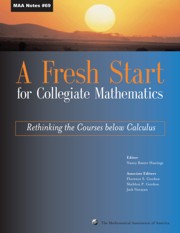Book contents
- Frontmatter
- Preface
- Contents
- Introduction
- Background
- Theme 1 New Visions for Introductory Collegiate Mathematics
- Theme 2 The Transition from High School to College
- Theme 3 The Needs of Other Disciplines
- Theme 4 Student Learning and Research
- Theme 5 Implementation
- Theme 6 Influencing the Mathematics Community
- Ideas and Projects that Work: Part 1
- 30 College Precalculus Can Be a Barrier to Calculus: Integration of Precalculus with Calculus Can Achieve Success
- 31 College Algebra Reform through Interdisciplinary Applications
- 32 Elementary Math Models: College Algebra Topics and a Liberal Arts Approach
- 33 The Case for Labs in Precalculus
- 34 The Fifth Rule: Direct Experience of Mathematics
- Ideas and Projects that Work: Part 2
34 - The Fifth Rule: Direct Experience of Mathematics
from Ideas and Projects that Work: Part 1
- Frontmatter
- Preface
- Contents
- Introduction
- Background
- Theme 1 New Visions for Introductory Collegiate Mathematics
- Theme 2 The Transition from High School to College
- Theme 3 The Needs of Other Disciplines
- Theme 4 Student Learning and Research
- Theme 5 Implementation
- Theme 6 Influencing the Mathematics Community
- Ideas and Projects that Work: Part 1
- 30 College Precalculus Can Be a Barrier to Calculus: Integration of Precalculus with Calculus Can Achieve Success
- 31 College Algebra Reform through Interdisciplinary Applications
- 32 Elementary Math Models: College Algebra Topics and a Liberal Arts Approach
- 33 The Case for Labs in Precalculus
- 34 The Fifth Rule: Direct Experience of Mathematics
- Ideas and Projects that Work: Part 2
Summary
Introduction
In recent years, the use of multiple representations has become an important part of the teaching of mathematics at all levels. This paper describes how a laboratory approach to precalculus instruction can allow students to achieve mathematical insights using direct sensory experience of quantitative phenomena. Such experience can complement and inform the graphical-numerical-analytical-verbal models students use in problem-solving.
Since the beginning of the calculus reform movement, the Rule of Three has become an essential feature of mathematics education. Facilitated by the availability of technological aids to constructing graphs and tables, the use of multiple approaches in describing mathematical functions and processes is a cornerstone of current pedagogical practice throughout the K–16 mathematics curriculum.
Shortly after the Rule of Three construct was widely adopted and became part of the mathematics educator's lexicon, it evolved into the Rule of Four [1]. If analytical, graphical, and numerical representations are all different lenses through which mathematical relationships can be viewed, they are, in many cases, language-independent substitutes for connections or processes that can also be described in words. Thus, verbal description became a co-equal partner to the original trinity. In particular, describing a mathematical model in English (or any other language) can make mathematics more accessible for those who have not typically been successful with traditional symbol-intensive mathematics. Using language (written or oral) to articulate mathematical modes of thought has now become an integral part of the way we expect our students to approach mathematics [2].
- Type
- Chapter
- Information
- A Fresh Start for Collegiate MathematicsRethinking the Courses below Calculus, pp. 320 - 328Publisher: Mathematical Association of AmericaPrint publication year: 2006
- 1
- Cited by



